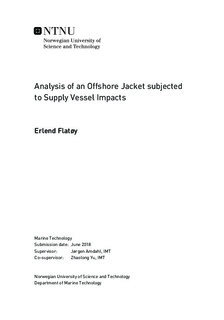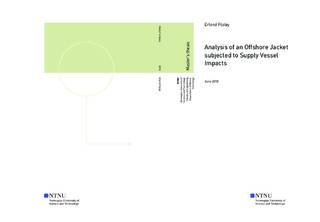| dc.description.abstract | In this master s thesis an offshore jacket platform subjected to supply vessel impacts is
analysed. Since the supply vessels have increased in size and have been reinforced through
modern ship design it has been of significance to study ship impacts with larger ships.
The collision scenarios are chosen based upon damage potential to critical members
such as risers and conductors and the damage potential to structural integrity. Two stern
collisions against risers, a side collision against the platform leg and a bow impact against
a conductor area have been analysed. The supply vessel used in this master s thesis had a
displacement of 7500 tonnes and according to new ALS-requirements the speed at impact
should be 3m/s for bow impacts and 2m/s for side and stern impacts. Hence, in view of
new collision requirements it is desirable to study whether the jacket platform is capable
to withstand a bow-, side and stern impact of 37.12MJ, 21MJ and 16.5MJ, respectively.
Local analyses have been performed with NLFEA in LS-DYNA while the global analyses
have been carried out in USFOS. All LS-DYNA analyses are decoupled, which means
that rigid body motions of the ship (e.g.: change in speed, direction due to impact) are not
considered. Furthermore, the LS-DYNA analyses were performed quasi-statically which
means that the ship was pushed towards the jacket platform at constant speed until the
internal energy (strain energy) reached the collision energy level.
Structural sub-models of the jacket platform were modelled and meshed in SESAM
GeniE. The structural ship models used in the LS-DYNA analyses are the same which are
included in DNVGL-RPC208. The bow-, side and stern model are all designed to be
representative for an OSV with a displacement in the range of 6500-10000 tonnes. The
USFOS-model was provided, and only minor modifications were done. During the LSDYNA
analyses the energy absorption in both ship and jacket was analysed. In USFOS,
the ship was presented as a nonlinear spring based upon the ship deformation behaviour
observed in LS-DYNA.
The stern collision showed that there was a severe damage potential to the risers. Due
to inaccurate modelling of the riser clamps and riser flanges it was not possible to judge
the risk of rupture. Inaccurate modelling of one of the clamps between one of the braces
and one of the risers caused rupture of the brace, a result which is questionable. Internal
pressure and temperature in the risers were not considered in the LS-DYNA analyses.
Another uncertainty was that a stern corner was used, and it is therefore questionable if
the boundary conditions along the geometrical symmetry plane are accurate. In the side
collision analysis deformation of both ship side and platform leg were achieved. Out of a
collision energy of 21MJ, 15.5MJ and 5.5MJ were dissipated by jacket and ship, respectively.
The bow impact against the conductor area showed that the conductors were strong
enough to crush the forecastle and deform the bow. Internal pressure in the conductors was not implemented due to the design of the conductor. Of 37MJ the ship absorbed 30MJ
while approximately 7MJ were dissipated by a diagonal which deformed in a three-hinge mechanism.
Due to time limitations a mesh convergence study was not carried out on
neither of the sub-models. Furthermore, strain rates were not included. The rupture and
tensile fracture criteria are also mesh dependent in NLFEA and must be chosen according
to calibration procedures in DNVGL-RPC208. These are the main uncertainties in the
LS-DYNA analyses.
In USFOS, the commands BIMPACT, MULT_IMP and SURFIMP were used. Despite
challenges of capture the dissipating energy, the energy dissipation results were close to
the results obtained with LS-DYNA. The stern collisions in USFOS gave reasonable results
regarding fracture of braces. Risers and clamps were also affected by the deformation
of the braces. In the side impact against the platform leg there were good coincidence with
the results obtained with LS-DYNA. Since the conductors are non-structural in USFOS,
the bow impact turned into a capacity check of the diagonal. The diagonal absorbed 9.5MJ
before fracture, while the diagonal absorbed 7MJ in LS-DYNA. For all collision scenarios
the damaged jacket survived the residual strength check without structural collapse. In the
residual strength check, the jacket platform was subjected to a 5th order Stoke wave with
a return period of 100 years.
The master s thesis has concluded that the stern corner of the ship managed to do severe
damage to the risers before it hit the platform, while the conductors seemed strong enough
to crush the ship. Recommendations for the SURFIMP-command are given in Appendix.
Based upon observations in LS-DYNA it was concluded that it is too optimistic to set
the dent width equal to the height of the contact area between the ship and the platform.
The dent widths in LS-DYNA were observed to be in the range of 0.1m-0.3m, instead of
2.5m-3m which was based upon ship geometry from earlier analyses. Smaller dent widths
cause a more concentrated collision which reduces the capacity of the platform leg. For
ship impacts against platform legs which do not stand perpendicular to the sea surface
it is recommended to choose a dent width based upon NLFEA-results rather than ship
geometry. | |

